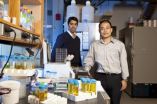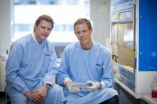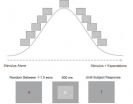2nd member in Alzheimer's toxic duo identified
Finding could lead to novel drugs that prevent or slow the disease
2011-02-04
(Press-News.org) SAN ANTONIO, Texas, U.S.A. (Feb. 4, 2011) — Like two unruly boys who need to be split up in class, a pair of protein molecules work together to speed up the toxic events of Alzheimer's disease. Researchers at the UT Health Science Center San Antonio today announced the discovery of the second molecule and said its identification could lead to drugs that disrupt the interaction, and thereby block or slow Alzheimer's onset or progression.
Alzheimer's disease is an irreversible, progressive brain disease marked by deterioration of nerve cells and eventual complete loss of cognitive functioning – thinking, memory and reason. Many Alzheimer's patients have brain lesions called amyloid plaques, which consist of protein fragments called amyloid-beta. Small aggregates of amyloid-beta are thought to contribute prominently to the degeneration of brain cells in Alzheimer's.
How genes are activated
The discovery involves an amyloid beta fragment called AICD. Scientists have known that AICD controls expression of genes that contribute to Alzheimer's, but how it did so was unclear – until now. "We discovered a protein molecule that communicates with AICD to turn on target genes," said Thomas G. Boyer, Ph.D., professor of molecular medicine at the Health Science Center. "We hope to exploit this knowledge to identify compounds or drugs that can disrupt these signals, leading to a novel and effective treatment for this disease."
Alzheimer's disease is the most common cause of dementia among older people, and estimates indicate that as many as 5.3 million Americans suffer from it. While several drugs approved by the U.S. Food and Drug Administration can temporarily slow worsening symptoms, no treatment is currently available to slow or stop the degeneration of nerve cells that lies at the root of the disease.
INFORMATION:
The finding is in the Feb. 4 issue of EMBO Reports, published by the European Molecular Biology Organization. The research is the doctoral dissertation of Xu Xuan, a student in Dr. Boyer's laboratory at the Health Science Center's Institute of Biotechnology. The other co-author is Haiying Zhou, who obtained her Ph.D. in the Boyer laboratory and is pursuing postdoctoral studies at the University of California, Berkeley.
On the Web and Twitter
For current news from the UT Health Science Center San Antonio, please visit our news release website or follow us on Twitter @uthscsa.
About the UT Health Science Center San Antonio
The University of Texas Health Science Center at San Antonio, one of the country's leading health sciences universities, ranks in the top 3 percent of all institutions worldwide receiving National Institutes of Health (NIH) funding. Research and other sponsored program activity totaled a record $259 million in fiscal year 2009. The university's schools of medicine, nursing, dentistry, health professions and graduate biomedical sciences have produced approximately 26,000 graduates. The $744 million operating budget supports eight campuses in San Antonio, Laredo, Harlingen and Edinburg. For more information on the many ways "We make lives better®," visit www.uthscsa.edu.
END
ELSE PRESS RELEASES FROM THIS DATE:
2011-02-04
A new way of splitting layered materials to give atom thin "nanosheets" has been discovered. This has led to a range of novel two-dimensional nanomaterials with chemical and electronic properties that have the potential to enable new electronic and energy storage technologies. The collaborative* international research led by the Centre for Research on Adaptive Nanostructures and Nanodevices (CRANN), Trinity College Dublin, Ireland, and the University of Oxford has been published in this week's Science.
The scientists have invented a versatile method for creating these ...
2011-02-04
The human body has a remarkable ability to heal itself. Due to the presence of dedicated stem cells, many organs can undergo continuous renewal. When an organ becomes damaged, stem cells in the organ are typically activated, producing new cells to regenerate the tissue. This activity of stem cells, however, has to be carefully controlled, as too much stem cell activity can cause diseases like cancer. Current research in stem cell biology is starting to unravel the control mechanisms that maintain a balance between efficient regeneration and proper control of stem cell function. ...
2011-02-04
Cold Spring Harbor, N.Y. – A constellation of different stem cell populations within our skin help it to cope with normal wear and tear. By constantly proliferating, the stem cells allow skin to replenish itself, allowing each cell to be replaced by a new one about once a month. But the normal cycle of division and death within one or more of these stem cell types can sometimes be derailed by genetic mishaps. Such events are believed to spawn carcinomas and other deadly skin cancers, which are the mostly frequently diagnosed cancers in the United States.
Researchers ...
2011-02-04
Surprising new evidence which overturns current theories of how humans colonised the Pacific has been discovered by scientists at the University of Leeds, UK.
The islands of Polynesia were first inhabited around 3,000 years ago, but where these people came from has long been a hot topic of debate amongst scientists. The most commonly accepted view, based on archaeological and linguistic evidence as well as genetic studies, is that Pacific islanders were the latter part of a migration south and eastwards from Taiwan which began around 4,000 years ago.
But the Leeds research ...
2011-02-04
New research shows that the 2010 Amazon drought may have been even more devastating to the region's rainforests than the unusual 2005 drought, which was previously billed as a one-in-100 year event.
Analyses of rainfall across 5.3 million square kilometres of Amazonia during the 2010 dry season, published tomorrow in Science, shows that the drought was more widespread and severe than in 2005. The UK-Brazilian team also calculate that the carbon impact of the 2010 drought may eventually exceed the 5 billion tonnes of CO2 released following the 2005 event, as severe droughts ...
2011-02-04
WALNUT CREEK, Calif.—A tiny crustacean that has been used for decades to develop and monitor environmental regulations is the first of its kind to have its genetic code sequenced and analyzed—revealing the most gene-packed animal characterized to date. The information deciphered could help researchers develop and conduct real-time monitoring systems of the effects of environmental remediation efforts.
Considered a keystone species in freshwater ecosystems, the waterflea, Daphnia pulex, is roughly the size of the equal sign on a keyboard. Its 200 million-base genome was ...
2011-02-04
La Jolla, CA, February 2, 2011 – Embargoed by the journal Science until February 3, 2011, 2 PM, Eastern time - A team of scientists at The Scripps Research Institute has discovered a new way to stabilize proteins — the workhorse biological macromolecules found in all organisms. Proteins serve as the functional basis of many types of biologic drugs used to treat everything from arthritis, anemia, and diabetes to cancer.
As described in the February 4, 2011 edition of the journal Science, when the team attached a specific oligomeric array of sugars called a "glycan" to ...
2011-02-04
In a discovery that may lead to a new treatment for breast cancer that has spread to the bone, a Princeton University research team has unraveled a mystery about how these tumors take root.
Cancer cells often travel throughout the body and cause new tumors in individuals with advanced breast cancer -- a process called metastasis -- commonly resulting in malignant bone tumors. What the Princeton research has uncovered is the exact mechanism that lets the traveling tumor cells disrupt normal bone growth. By zeroing in on the molecules involved, and particularly a protein ...
2011-02-04
Australian scientists have successfully cleared a HIV-like infection from mice by boosting the function of cells vital to the immune response.
A team led by Dr Marc Pellegrini from the Walter and Eliza Hall Institute showed that a cell signaling hormone called interleukin-7 (IL-7) reinvigorates the immune response to chronic viral infection, allowing the host to completely clear virus. Their findings were released in today's edition of the journal Cell.
Dr Pellegrini, from the institute's Infection and Immunity division, said the finding could lead to a cure for chronic ...
2011-02-04
The human brain works incredibly fast. However, visual impressions are so complex that their processing takes several hundred milliseconds before they enter our consciousness. Scientists at the Max Planck Institute for Brain Research in Frankfurt am Main have now shown that this delay may vary in length. When the brain possesses some prior information − that is, when it already knows what it is about to see − conscious recognition occurs faster. Until now, neuroscientists assumed that the processes leading up to conscious perception were rather rigid and that ...
LAST 30 PRESS RELEASES:
[Press-News.org] 2nd member in Alzheimer's toxic duo identified
Finding could lead to novel drugs that prevent or slow the disease



